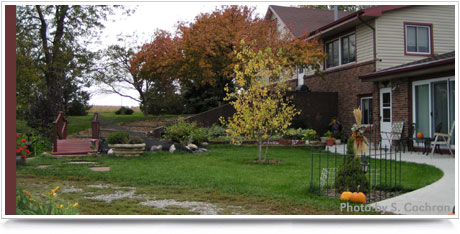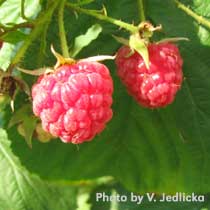Exploring Horticulture
This section discusses creating a Sustainable Nebraska Landscape by selecting landscape plants, trees and turf suited for this area.

A Sustainable Nebraska Landscape... minimizes high maintenance turfgrass areas, utilizes plant material for shade, wind protection, erosion control and beauty, and uses native/adapted plant species to save on maintenance costs.
Get the most for your plant dollar! Besides choosing plants for their flower, consider plant species that offer:
- multi-season beauty
- healthy, pest-resistant foliage
- fall coloration
- persistent fruit for attracting wildlife
- interesting bark, buds, or seed heads for winter viewing
For more information on environmentally-sound landscape design and management, refer to the Nebraska Statewide Aboretum "What to Plant".
TIPS
-
Choose the right plant for the right place; sun-loving plants require at least six hours of direct sunlight per day, shade-loving species must have shade, and stream bank areas or low areas are needed for plants that prefer wet feet.
-
Mulch beds to reduce weeds, conserve soil moisture, reduce soil temperature, and lessen "mower blight" of desirable trees and shrubs.
-
Position plants with the ultimate height and width in mind. This minimizes overplanting and costly plant removal.
-
Why choose water-efficient plant species? By lessening the need for irrigation, homeowners decrease the chance of erosion, runoff, and nonpoint source pollution.
-
Organic matter added to soil will loosen a clay soil, increase water-holding capacity of sandy soils, make soil easier to till, and provide nutrients.
- Lawn maintenance is a labor- and money-intensive chore. Mowing, watering, weeding, fertilizing and equipment upkeep account for the bulk of landscape maintenance. Lower these demands by limiting turfgrass area, using native buffalograss which requires less inputs, and implementing mulched beds.
For diversity, consider using all of the following types of plants in your landscape.
- Annuals for quick color, as a filler
- Perennials for long-term color
- Vines-twining and clinging to suit any situation
- Shrubs
- Trees-for shade, understory
Source: Adapted for Lancaster County, Nebraska from A Place in the Country: The Acreage Owner's Guide (EC97-2506C).
* Publications & Resources are available from your local Extension Office (Find Your Office Here)

Native and Adapted Plants for Nebraska...
-
are hardy to USDA hardiness zone 4 or 5 (depending on where you live)
-
tolerate the desiccating winds of summer and winter
-
resist disease and insect pests to minimize homeowner pesticide use
-
possess deep root systems for maximum drought tolerance
-
use existing soil fertility with low-input fertilizer applications
- tolerate Nebraska winters, i.e., periods of minimal snow cover, desiccating winds, temperature extremes, and winter warm spells
Questions about the hardiness of a plant? Contact Your Extension Office
More Acreage Resources & Small Farm Resources